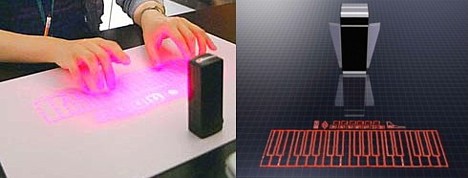
Digital Information Development (DID) has developed a highly portable virtual piano that is played with a keyboard consisting of projected laser beams.
The box-shaped device measures about 10 x 3 x 3 cm (4 x 1 x 1 in.) and weighs about 100 grams (3.5 oz.). Using a red semiconductor laser module and holographic optical element, the device projects a 25-key 2-octave keyboard onto the surface in front of it (black surfaces don't work because they absorb the light). A CMOS camera module and infrared (invisible) red semiconductor laser module detect which keys are touched, and the corresponding notes are emitted from speakers built into the device. Chords can also be played, and DID claims it is technically possible to reproduce weighted notes (but presumably not with this version).
The keyboard has 3 other voices in addition to piano -- organ, pipe organ and harpsichord. It is scheduled for release in Japan in November 2006 and is expected to cost around 15,000 yen (US$130).
DID says that a virtual 88-key grand piano can be created by increasing the size of the device.
[Source: Yomiuri Shimbun]

Face
Okay. It's neat to look at and all but have they done anything in the way of actual innovation of the instrument. See what I mean here. A list of the most innovative keyboards ever...
http://www.windowatch.com/blog/2006/12/top-5-keyboard-innovations-that-shaped.html
Some where over the the rainbow
shit shit shit.. Great concept but stupid application. You cant use laster for this type of system. I just wont work... Try pressing 2 or more keys at once.. Yeah you never thought of that when you made it.
ray brohinsky
actually, it can register more than one key-press at the same time. Check out the virtual laser keyboard (same technology, different hologram displaying a QWERTY keyboard) at http://www.virtual-laser-keyboard.com
The laser displays the keyboard on the flat surface. The built-in camera measures when your fingers enter the space a few milimeters above the projected key outline. It can detect multiple entries into multiple spaces. So actually, they did think of it when they made it. My guess is that they are also sensing velocity as well, but that is just a guess.
The question is whether the time of detection and processing makes too much lag to play the thing.
Bart
Some small question:
1) How about piano touch velocity. I made software for that on keys, but you need to measure the time that you press the key hahaha.... virtually impossible yet.
2) How about after-touch... can the laser measure if I do after touch and more blood is going to my finger or so... ?
3) Can this be made in my telephone, would be nice at the office hahaha...
melly
how do i learn piano lessons fast
A.Aldraie
Are you looking for a Dealer in Netherlands
Sam
Dude, that is freakin awesome, i want one
Sam
where is the speaker though?